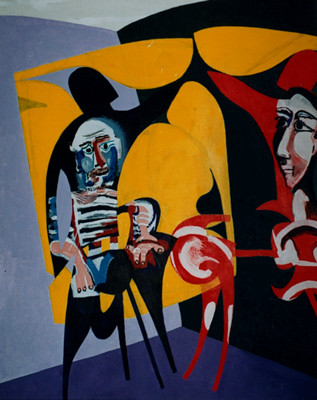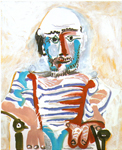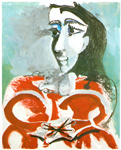|
 |
Pablo and Jacqueline (Painting #7)
Acrylic Paint on Canvas, January 2002, 75cm x 60cm
 |
 |
Picasso, Self Portrait, 3-4 April 1965, Oil on Canvas, 99.5 x 80.5 cm.
|
|
|
|
Picasso, Portrait of Jacqueline, 4-5 April 1965, Oil on Canvas, 99.5 x 80.5 cm.
|
|
Pablo and Jacqueline (Painting #7)
This painting reflects a shift from earlier drawing and paintings in that there are two Centaur forms included as compared to one in previous works. (‘Centaur Painting 5’ has 2 Centaurs, one of which is a shadow).
The intention for this painting was to paint the forms in silohuette and overlay both a 3D Centaur form and a 2D plan view of th Centaur.
This painting incorporates a transcription of a self portrait of Pablo Picasso and a painting of Picasso’s one-time partner Jacqueline.
Firstly, the portrait of Picasso on the left Centaur. There is a wonderful gestalt effect here whereby you can look at the Centaur form and the Picasso portrait as separate images and you can also see them together as one. When you see them as one image, Pablo appears to be sitting in or on the Centaur. The Centaur appears as if it is a chair.
Secondly, the Jacqueline portrait on the right Centaur and in particular the nape of the neck that fits so neatly with the curve of the Centaur form. This could be reworked later to heighten this effect further.
Thirdly, the spatial effect of the painting as a whole. At the bottom of the picture is a series of straight lines that suggest a cubic space which captures the legs of the Centaur forms and suggests they are in this cubic space. In contrast, at the top of the painting is a series of curved lines. The overall effect is a multiple of layers of spatial references that depending upon where you look give off a slightly different effect. This is accentuated by the use of color with the green being a strong influence and the yellow almost floating across the front, albeit behind the Centaur forms.
previous • next
|
 |
| |
|
|

|
|



